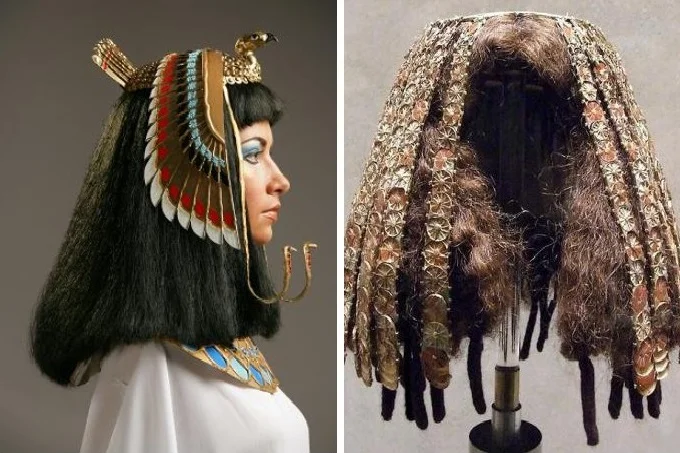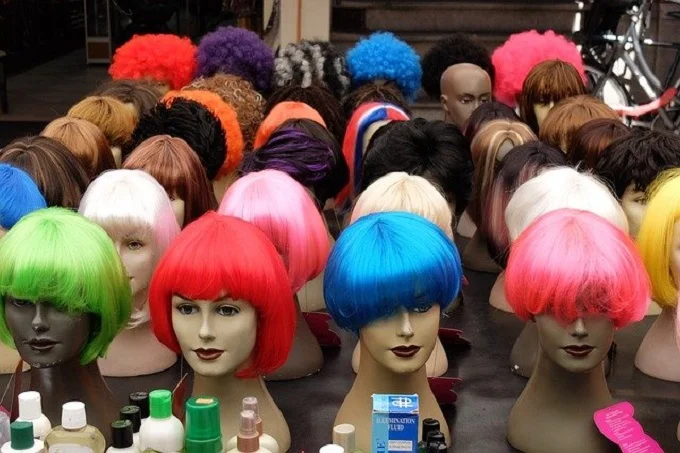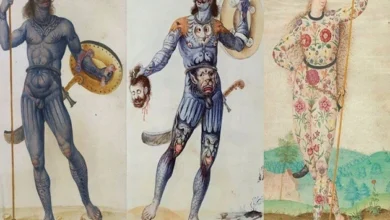History of wigs in Africa, but why did ancient Egypt wear wigs?

In today’s world, no one can be surprised by a wig in calm and natural shades, as well as the most shouty and provocative colors of false hair. Not everyone knows the history of the appearance of this item. It dates back to Ancient Egypt.
Throughout the history of wig’s existence, the wigs, more than once rose to the fashion Olympus, but not once fell from it. Nevertheless, the love for hair extensions is still alive. Therefore it is useful to remember the history of the appearance of wigs and the peculiarities of their making.
History of wigs in Africa and the peculiarities of their making
For the first time, the wig was invented in Ancient Egypt
Ancient documents say that the history of the development of wigs is closely intertwined with the history of the development of mankind. The use of “false hair” is repeatedly mentioned in the archives of Babylon, Sumerian Kingdom, Ancient Egypt, Assyria, and other states.

Ancient people of Africa greatly favored the wigs, and there are several explanations for this fact. First, in those years, when they reached adulthood, all boys and girls sacrificed their hair to the gods. They had their hair cut off bald, and their heads were covered with a wig. Secondly, the climate in ancient Egypt was very hot. In the evening, the lack of hair gave people the desired coolness, and during the day, they were saved from the heat by the wig. It is worth noting that absolutely everyone’s wigs were worn – both the pharaohs and the commoners.
For the production of wigs, different materials were used – horsehair, wool of sheep and other animals, as well as human hair. By the way, wigs made of the latter could only afford by the rich people and pharaohs. Commoners got out as they could, they made themselves wigs from improvised materials (sometimes even oakum was used for that), because it was simply unacceptable to appear in the Egyptian society without a wig.
Wigs simply conquered the Roman Empire
Towards the middle of the first millennium BC, the fashion for wigs began to spread actively around the world. This object of these hairs extension simply conquered the countries of the Mediterranean and the Middle East. The Kings of Persia, inspired by the Pharaohs, wore wigs with intricate styling and adorned with precious stones.
The Romans loved wigs most of all. In this state, fashionable women bought wigs from all over the world. They put on their heads “superimposed hair” of different colors: black – from India, blond and red – from Germany, white – from Scandinavia. It is worth mentioning that wigs of dark shades were considered a sign of high morality, and were worn by noble ladies and gentlemen. Light-colored wigs were worn by courtesans, as “fake hair” of that color represented promiscuity.
Why wigs were so popular in Europe in past years
In England, the fashion for wigs began in the 16th and 17th centuries when Queen Elizabeth I of England lost her hair due to suffering from a severe form of smallpox. She had to wear a wig to hide her bald head. The court nobility supported their mistress and also began to use this article of toiletry.
Immediately after England, the fashion for wigs spread to France. Louis XIV, who ruled the country at the time, had very impressive baldness on his head, and therefore the wig became his salvation. It’s also worth noting that Louis XIV obliged all the male class to wear this accessory, and a little later, it was adopted by the French women. The latter, by the way, were building on their heads these miniatures and installations, decorating their hairstyles from wigs with flowers, jewels, feathers, and even fruits.
The birth of wig fashion in Europe
Many people in Europe did not wear wigs because it was fashionable or beautiful. They were trying to hide the traces of a deadly venereal disease that had been plaguing Europe for several hundred years. Since baldness was one of the symptoms of the disease, people wore wigs to escape the shame. The fashion for wigs spread quickly because not only did they help hide hair loss, but they were also beautiful and attractive.
It is not unreasonable to note that every self-respecting aristocrat had several wigs at his disposal. “False hair” of black color was put on, as a rule, in the morning, brown wigs were worn in the daytime, and in the evening, they covered the head with white artificial curls. If a person did not have a white wig, he wore a regular wig, heavily powdered with flour or powder.
One of the reasons wigs were so popular in Europe was lice. Many people often suffered from them. Sometimes the only way to get rid of these parasites was to have no hair at all. To hide the imperfections of his body in such cases helped people wig. Sometimes lice were infested in wigs, but it was much easier to get rid of them in “false hair” than in natural hair. It was enough just to boil the wig.
In Russia, the wigs appeared thanks to Peter I, who himself used this object. Russian women immediately appreciated the European novelty on its merits, officials put on the artificial hair reluctantly, but the clergy was against wigs. Nevertheless, even then, it was clear that the wigs in Russia were to be.
Peter I organized his hairdressing workshops, as he did not want to depend on foreign professionals. In Russia, lush designs with “false hair” were also fashionable, and in 1730 Biron introduced the fashion for simpler wigs. In the army in those years, it was mandatory for soldiers to wear wigs. However, taking care of them was not easy, so Grigory Potemkin proposed abolishing the rule of wearing wigs in the Russian army. Catherine II supported this because Grigory was her favorite.
What is interesting about the process of making wigs nowadays
The fashion for wearing wigs lasted until the end of the XVIII century. Wigs “returned” their popularity only after two hundred years. The synthetic boom in the XX century contributed to the fact that artificial hair became more accessible for people and helped them to solve many problems with the lack of hair.

In 1957 a new era of triumph for wigs began, as new thin and lightweight algae fibers (kanekalon) were produced in Japan. In the nineties, wigs made of “new wool” were very popular among the world’s stars.
Wigs are very popular at the present time. Many people wear them to hide the traces of diseases, as they did before. For example, to disguise the effects of chemotherapy for cancer. Some individuals wear wigs to emphasize their personality and to stand out among others. Wig making technology does not stand still. People are trying to make them even more comfortable and beautiful, which means that wigs are unlikely to lose their relevance even years from now.




